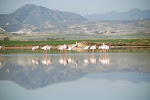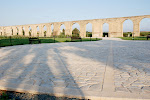Cyprus is very well known for its periodic droughts and low waterfall winters causing severe scarcity of water. This characteristic has been the rule through its long history until today. The city of Larnaca was born at the beginning of the 2nd millennium B.C. as the island’s major port, due to the copper richness of the island, its geographical strategic navigation positioning in the Eastern Mediterranean and the fiord-like natural ports of the kingdom of Kition (Larnaca) at the time. At the beginning, the city’s water supply from wells was very sufficient, but the population within the city walls since Archaic Times (700-480 BC) increased tremendously. So, several methods of enriching the water supply have been used and methods for extensive underground depositing in clay – argil cisterns have been discovered by the archaeologists.
Later on, the technology of “Persian Quanats” has been imported by the city, which seem to be known since the Persian conquest of the Island on 546 BC, perhaps even before. The last part of a “Persian Quanats” channel-system has been discovered recently in the archaeological site of the ancient port of the Classical times of Larnaca (480-300 BC.). This sophisticated water supply system was obviously bringing sufficient quantities of water from secret sites outside the city walls, trying to satisfy the needs of a populous city and of a busy military and commercial port in turbulent periods when the town was facing strong enemies and long-lasting sieges. A tomb inscription of this period refer to the “Minister of the king of Kition responsible for the water supply of the kingdom”, an officialdom held by his family for six generations before him! Therefore, organized, wise, efficient and official administration of the water needs of the town can be traced even before the Archaic Period (700-480 BC).
On 45 AD Saint Barnabas and Evangelist Marcus passed by Roman period Kition and in the book “Secret Acts of Saint Barnabas” thought to be written by Saint Marcus, a detailed account of their visit in Larnaca is mentioned. A long stay for refreshing at the public aqueduct of Kition is well described. The city was then at its most populous face and the operation of public aqueducts was a mere necessity with which the Roman and later the Byzantine State policies are known to have financed and encouraged in great devotion. Archeological findings of this period in Larnaca show extensive distribution networks with clay pipes, which seem to carry water through small valleys and hills despite the general unscientific view of the Romans that such thing could not be, thus constructing sophisticated arched and leveled channels to pass aqueduct water over valleys. It seems that hydraulic wisdom in Larnaca was in practice several centuries before Pascal?
At the time that Larnaca became once again the main port and populous center of Cyprus, between the years 1746-48 AD, the Ottoman Governor of Larnaca “Bekir Pashia” claimed that he constructed a new Aqueduct for Larnaca. A 15 kilometers long aqueduct, with 7 kilometers long underground Persian Quanats initiating at river Tremithos, and with an 8 kilometer long over ground channel passing through 3 different small valleys over arched beautiful constructions, all in excellent condition until today. All these together with the surviving grain mill on the channel, comprise a great monument of the water wisdom of the area. The administration document of the water of the Bekir Pashia aqueduct is surviving too. However, a closer look at the archaeological and literal evidence indicate, that the Bekir Pashia aqueduct was an extensive reparation and renovation of pre-existing installations of the ancient aqueducts of the city, which have been also in operation through Medieval times as some literal evidence show.
Proposed actions
The 15 kilometer long aqueduct of Larnaca is today an ancient monument protected by law. The larger of its arched constructions have been maintained by the Cyprus Department of Antiquities, but the other two smaller arched constructions urgently need maintenance and visiting access for tourists and locals. Maintenance and visiting access is also required for the 7 kilometer underground Persian Quanats.
The tomb inscription of the Water Minister of the Kingdom of Kition it is today at the basement of the British Museum. This historically important and unique inscription for the water history of the area should be requested by the appropriate authorities to be returned to Larnaca and comprise with the rest of the rich water distribution relics etc, now at the storehouses of the Larnaca Museum, the material for a Museum of the ancient water conservation wisdom, to operate near the surviving aqueduct of Larnaca. Such a Museum must also give to the new generations the necessary information for developing a water conservation consciousness.
The grain water mill surviving on the channel of the Bekir Pashia aqueduct is at a condition that can be put in continuous demonstrative operation. Improvement of the visiting access is also needed.
A scientific study for the dating of the several parts of the Bekir Pashia aqueduct is also needed, as it will show the continuity and sufficiency of the water supply systems of the previous eras.
The preparation of a book in English about the Larnaca experience in diachronic water supply systems as a case study for today is also recommended. Most of the material is ready and published in Greek by Alexis Michaelides and Sophocles Christodoulides and an updating and more scientific presentation of their work can be a serious document of ancient water wisdom.
Sustainability of actions
The Larnaca aqueduct is considered both by national and local authorities as an invaluable monument. However, its proper contemporary use is now confused and everything related to its existence is idle. We believe that it has a new great role to play especially in the elevating local water reservation consciousness and enriching the tourist product of Cyprus. Therefore, many government agencies and authorities will be eager to help in all above actions provided these actions are presented to them in a proper, convincing and ready for implementation, especially by international organizations and euro-med programs.
The Cyprus authorities that can get involved in helping and financing above proposed actions are:
• Ministry of Agriculture, Natural Resources and Ecology
• Ministry of Commerce, Industry and Tourism
• Ministry of Education and Culture
• Municipality of Larnaca
The British and Cyprus Museum authorities can help with providing most of the exhibits, but for sustainability of the Water History Museum and Wisdom we need the commitment and support of the Municipality and Water Board of Larnaca, which we can be easily obtained.
Financing an archeologist specialist in dating ancient aqueducts can be realized through UNESCO as such monuments are part of world heritage.
The financing of the edition can go through some of the Global Water Sustainability Organizations as it will be a case study for world heritage research in water wisdom and conservation in the area.
Larnaca 10.02.2008
Alexis Michaelides
Writer and researcher
Larnaca Deputy Mayor
Subscribe to:
Post Comments (Atom)







No comments:
Post a Comment